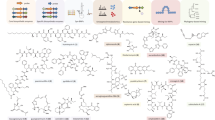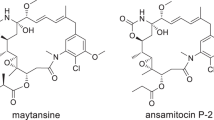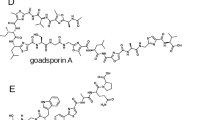Abstract
The interplay between chemical and biological approaches to drug discovery and development is increasing with the advent of combinatorial methods that accelerate the output of screening programs and the development of genetically modified microorganisms able to make new metabolites and larger amounts of known ones. Actinomycetes, the most prolific microbial source of known drugs, can produce new aromatic compounds by manipulation of the Type II polyketide synthase genes as well as analogs of existing macrolide antibiotics, unavailable by chemical synthesis, through targeted mutation of specific biosynthetic genes. Genetic alteration of pathways to aminoglycoside and oligopeptide antibiotics should offer equally promising approaches to manufacturing novel metabolites. When coupled with DNA–based prescreening of microbial isolates for genes associated with known pharmacologically active agents, these new genetic–based approaches are creating an expanded role for microorganisms in drug research.
This is a preview of subscription content, access via your institution
Access options
Subscribe to this journal
Receive 12 print issues and online access
209,00 € per year
only 17,42 € per issue
Buy this article
- Purchase on SpringerLink
- Instant access to full article PDF
Prices may be subject to local taxes which are calculated during checkout
Similar content being viewed by others
References
Anderson, S., Marks, C.B., Lazarus, R., Miller, J., Stafford, K., Seymour, J., Light, D., Rastetter, W. and Estell, D. 1985. Production of 2-keto-L-gulonate: an intermediate in L-ascorbate synthesis by a genetically modified Erwinia herbicola. Science 230: 144–149.
Murdock, D., Ensley, B.D., Serdar, C. and Thalen, M. 1993. Construction of metabolic operons catalyzing the de novo biosynthesis of indigo and Escherichia coli. Bio/Technology 11: 381–386.
Draths, K.M., Ward, T.L. and Frost, J.W. 1992. Biocatalysis and nineteenth century organic chemistry: conversion of D-glucose into quinoid organics. J. Am. Chem. Soc. 114: 9725–9726.
Skatrud, P.L., Tietz, A.J., Ingolia, T.D., Cantwell, C.A., Fisher, D.L., Chapman, J.I. and Queener, S.W. 1989. Use of recombinant DNA to improve production of cephalosporin C by Cephalosporium acremonium. Bio/Technology 7: 477–485.
Isogai, T., Fukagawa, M., Aramuri, I., Iwami, M., Kojo, H., Ono, T., Ueda, Y., Kohsaka, M. and Imanaka, H. 1991. Construction of a 7-aminocephalosporanic acid (7ACA) biosynthetic operon and direct production of 7ACA in Acremonium chrysogenum. Bio/Technology 9: 188–191.
Cantwell, C., Beckmann, R., Whiteman, P., Queener, S.W. and Abraham, E.P. 1992. Isolation of deacetoxycephalosporin C from fermentation broths of Penicillium chrysogenum transformants: construction of a new fungal biosynthetic pathway. Proc. R. Soc. London Ser. B, 248: 283–289.
Pavia, M.R., Sawyer, T.K. and Moos, W.H. 1993. The generation of molecular diversity. Bioorg. Med. Chem. Lett. 3: 387–396.
Amato, I. 1992. Speeding up a game of chance. Science 257: 330–331.
Brenner, S. and Lerner, R.A. 1992. Encoded combinatorial chemistry. Proc. Natl. Acad. Sci. USA 89: 5381–5383.
Ellman, J.A. and Bunin, B.A. 1992. A general and expedient method for the solid-phase synthesis of 1,4-benzodiazepine derivatives. J. Am. Chem. Soc. 114: 10997–10998.
Borchardt, A. and Still, W.C. 1994. Synthetic receptor binding elucidated with an encoded combinatorial library. J. Am. Chem. Soc. 116: 373–374.
Chen, J.K., Lane, W.S., Brauer, A.W., Tanaka, A. and Schreiber, S.L. 1993. Biased combinatorial libraries: novel ligands for the SH3 ___domain of phosphatidylinositol 3-kinase. J. Am. Chem. Soc. 115: 12591–12592.
Malpartida, F., Halam, S.E., Kieser, H.M., Motamedi, H., Hutchinson, C.R., Butler, M.J., Sugden, D.A., Warren, M., McKillop, C., Bailey, C.R., Humphreys, G.O. and Hopwood, D.A. 1987. Homology between Streptomyces genes coding tor synthesis of different polyketides used to clone antibiotic biosynthetic genes. Nature 325: 818–821.
Bibb, M.J., Biro, S., Motamedi, H., Collins, J.F. and Hutchinson, C.R. 1989. Analysis of the nucleotide sequence of the Streptomyces glaucescens tcmI genes provides key information about the enzymology of polyketide antibiotic biosynthesis. EMBO J. 8: 2727–2736.
Sherman, D.H., Malpartida, F., Bibb, M.J., Kieser, H.M., Bibb, M.J. and Hopwood, D.A. 1989. Structure and deduced function of the granaticin-producing polyketide synthase gene cluster of Streptomyces violaceoruber TU22. EMBO J. 8: 2717–2725.
Donadio, S., Staver, M.J., McAlpine, J.B., Swanson, S.J. and Katz, L. 1991. Modular organization of genes required for complex polyketide biosynthesis. Science 252: 675–679.
Cortes, I., Haydock, S.F., Roberts, G.A., Bevitt, D.J. and Leadlay, P.F. 1990. An unusually large multifunctional polypeptide in the erythromycin polyketide synthase of Saccharopolyspora erythraea. Nature 346: 176–178.
Reeves, P. 1993. Evolution of Salmonella O antigen variation by interspecific gene transfer on a large scale. Tr. Genetics 9: 17–22.
Stockmann, M. and Piepersberg, W. 1992. Gene probes for the detection of 6-deoxyhexose metabolism in secondary metabolite-producing streptomycetes. FEMS Microbiol. Lett. 90: 185–190.
Epp, J.K., Huber, M.L.B., Turner, J.R., Goodson, T. and Schoner, B.E. 1989. Production of a hybrid macrolide antibiotic in Streptomyces ambofaciens and Streptomyces lividans by introduction of a cloned carbomycin biosynthetic gene from Streptomyces thermotolerans. Gene 85: 293–301.
Hara, O. and Hutchinson, C.R. 1992. A macrolide 3-O-acyltransferase gene from the midecamycin-producing Streptomyces mycarofaciens. J. Bacteriol. 174: 5141–5144.
Summers, R.G., Wendt-Pienkowski, E., Motamedi, H. and Hutchinson, C.R. 1992. Nucleotide sequence of the region of the tcmII-tcmIV region of the tetraceomycin C biosynthetic gene cluster of the Streptomyces glaucescens and evidence that the tcmN gene encodes a multifunctional cyclase-dehydratase-O-methyltransferase. J. Bacteriol. 174: 1810–1820.
Decker, H., Motamedi, H. and Hutchinson, C.R. 1993. The nucleotide sequence and heterologous expression of tcmG and tcmP, biosynthetic genes for tetracenomycin C in Streptomyces glaucescens. J. Bacteriol. 175: 3876–3886.
Madduri, K., Torti, F., Colombo, A.L. and Hutchinson, C.R. 1993. Cloning and sequencing of a gene encoding carminomycin 4-O-methyltransferase from Streptomyces peucetius and its expression in Escherichia coli. J. Bacteriol. 175: 3900–3904.
Basinski, M., Bierman, M. and Schoner, B. 1994. Cloning of polyketide biosynthetic genes using colony hybridization and PCR. Top. Industr. Microbiol. In press.
McAlpine, J.B., Tuan, J.S., Brown, D.P., Grebner, K.B., Whittern, D.N., Buko, A. and Katz, L. 1987. New antibiotics from genetically engineered actinomycetes. I. 2-Norerythromycins, isolation and structural determinations. J. Antibiotics 40: 1115–1122.
Weber, J.M., Leung, J.O., Swanson, S.J., Idler, K.B. and McAlpine, J.B. 1991. An erythromycin derivative produced by targeted gene disruption in Saccharopolyspora erythraea. Science 252: 114–117.
Donadio, S., McAlpine, J.B., Sheldon, P.J., Jackson, M. and Katz, L. 1993. An erythromycin analog produced by reprogramming of polyketide synthesis. Proc. Natl. Acad. Sci. USA 90: 7119–7123.
Morimoto, S., Takahashi, Y., Watanabe, Y. and Omura, S. 1984. Synthesis and antibacterial activity of 6-methylerythromycins A. J. Antibiotics 37: 187–189.
Stassi, D., Donadio, S., Staver, M.J. and Katz, L. 1993. Identification of a Saccharopolyspora erythraea gene required for the final hydroxylation step in erythromycin biosynthesis. J. Bacteriol. 175: 182–189.
Haydock, S.F., Downson, J.A., Dhillon, N., Roberts, G.A., Cortes, J. and Leadlay, P.F. 1991. Cloning and sequence analysis of genes involved in erythromycin biosynthesis in Saccharopolyspora erythraea: sequence similarities between EryG and a family of S-adenosylmethionine-dependent methyltransferases. Mol. Gen. Genet. 230: 120–128.
Proctor, R.H. and Hohn, T.M. 1993). Aristolochene synthase. Isolation, characterization, and bacterial expression of a sesquiterpenoid biosynthetic gene (Aril) from Penicillum roqueforti.. J. Biol. Chem. 268: 4543–4548.
Cane, D.E., Zhen, W., Oliver, J.S. and Hohn, T.M. 1993. Overproduction of soluble trichodiene synthase from Fusarium sporotrichioides in Escherichia coli. Arch. Biochem. Biophys. 300: 416–422.
Andersen, J.F. and Hutchinson, C.R. 1993. Substrate specificity of 6-deoxyerythronolide B hydroxylase, a bacterial cytochrome P450 of erythromycin A biosynthesis. Biochemisty 32: 1905–1913.
Huffman, G.W., Gesellchen, P.D., Turner, J.R., Rothenberger, R.B., Osborne, H.E., Miller, F.D., Chapman, J.L. and Queener, S.W. 1992. Substrate specificity of isopenicillin N synthase. J. Med. Chem. 35: 1897–1914.
Baldwin, J.E., Lynch, G.P. and Pitlik, J. 1991. γ-Lactam analogues of β-lactam antibiotics. J. Antibiotics 44: 1–24.
MacCabe, A. P., van Liempt, H., Palissa, H., Unkles, S., Riach, M.B.R., Pfeifer, E., von Dohren, H. and Kinghorn, J.R. 1991. δ-(L-α-Aminoadipyl)-L-cysteinyl-D-valine synthetase from Aspergillus nidulans. Molecular characterization of the acvA gene encoding the first enzyme of the penicillin biosynthetic pathway. J. Biol. Chem. 266: 12646–12654.
Baldwin, J.E., Adlington, R.M., Dryans, J.S., Lloyd, M.D., Sweell, T.J., Schofield, C.J., Baggaley, K.H. and Cassels, R. 1992. Enzymatic synthesis of bicyclic γ-lactams using clavaminic acid synthase. J. Chem. Soc. Chem. Commun. 1992: 877–879.
McDaniel, R., Ebert-Khosla, S., Hopwood, D.A. and Khosla, C. 1993. Engineered biosynthesis of novel polyketides. Science 262: 1546–1550.
McDaniel, R., Ebert-Khosla, S., Hopwood, D.A. and Khosla, C. 1993. Engineered biosynthesis of novel polyketides: Manipulation and analysis of an aromatic polyketid synthase with unproven catalytic specificities. J. Am. Chem. Soc. 115: 11671–11675.
Harris, T.M. and Harris, C.M. 1986. Biomimetic syntheses of aromatic polyketide metabolites. Pure Appl. Chem. 58: 283–294.
Shen, B. and Hutchinson, C.R. 1993. Enzymatic synthesis of a bacterial polyketide from acetyl and malonyl coenzyme A. Science 262: 1535–1540.
Katz, L. and Donadio, S. 1993. Polyketide synthesis: Prospects for hybrid antibiotics. Annu. Rev. Microbiol. 47: 875–912.
Marsden, A.F.A., Caffrey, P., Aparicio, J.F., Loughran, M.S., Staunton, J. and Leadlay, P.F. 1994. Strereospecific acyl transfers on the erythromycin-producing polyketide synthase. Science 263: 378–380.
von Dohren, H., Pfeifer, E., van Liempt, H., Lee, Y.-O., Pavela-Vrancic, M. and Schwecke, T. 1993. The nonribosomal system: What we learn from the genes encoding protein templates, p. 159–167. In: Industrial Microorganisms: Basic and Applied Molecular Genetics. Baltz, R.H., Hegeman, G.D. and Skatrud, P.L. (Eds.). American Society for Microbiology, Washington, DC.
Liu, H.-W. and Thorson, J.S. 1994. Pathways and mechanisms in the biogenesis of novel deoxy sugars by bacteria. Ann. Rev. Microbiol. 48: In press.
Chater, K.F. 1990. The improving prospects for yield increase by genetic engineering in antibiotic-producing Streptomycetes. Bio/Technology. 8: 115–121.
Stutzman-Engwall, K.S., Otten, S.L. and Hutchinson, C.R. 1992. Regulation of secondary metabolism in Streptomyces spp. and overproduction of daunorubicin in Streptomyces peucetlus. J. Bacteriol. 174: 144–154.
Anzai, H., Murakami, T., Imai, S., Satoh, A., Nagaoka, K. and Thompson, C.J. 1987. Transcriptional regulation of bialaphos biosynthesis in Streptomyces hygroscopicus. J. Bacteriol. 169: 3482–3488.
Hutchinson, C.R., Decker, H., Madduri, K., Otten, S.L. and Tang, L. 1994. Genetic control of polyketide biosynthesis in the genus Streptomyces. Anton. Leeu. J. Microbiol. XX: 1–12.
Horinouchi, S., Kito, M., Nishiyama, M., Furuya, K., Hong, S.-K., Miyake, K. and Beppu, T. 1990. Primary structure of AfsR, a global regulatory protein for secondary metabolite formation in Streptomyces coelicolor. Gene 95: 49–56.
Decker, H., Summers, R.G. and Hutchinson, C.R. 1994. Overproduction of the acyl carrier protein component of a Type II polyketide synthase stimulates production of tetracenomycin biosynthetic intermediates in Streptomyces glaucescens. J. Antibiotics 47: 54–63.
Thomas, D.I., Cove, J.H., Baumberg, S., Jones, C.A. and Rudd, B.A.M. 1991. Plasmid effects on secondary metabolite production by a Streptomycetes synthesizing an anthelmintic macrolide. J. Gen. Microbiol. 137: 2331–2337.
Malmberg, L.-H., Hu, W.-S. and Sherman, D.H. 1993. Precursor flux control through targeted chromosomal insertion of the lysine ε-aminotransferase (lat) gene in cephamycin biosynthesis. J. Bacteriol. 175: 6916–6924.
Hsieh, Y.-J. and Kolattukudy, P.E. 1994. Inhibition of erythromycin synthesis by disruption of malonyl-coenzyme A decarboxylase gene eryM in Saccharopolyspora erythraea. J. Bacteriol. 176: 714–724.
Massey, L.M., Sokatch, J.R. and Conrad, R.S. 1976. Branched-chain amino acid catabolism in bacteria. Bacteriol. Rev. 40: 42–54.
Tang, L. and Hutchinson, C.R. 1993. Sequence, transcriptional and functional analysis of the valine (branched-chain amino acid) dehydrogenase gene of Streptomyces coelicolor. J. Bacteriol. 175: 4176–4185.
Peter, R. and McKinstry, R.C. 1994. Three-dimensional modeling and drug development. Bio/Technology 12: 147–150.
Author information
Authors and Affiliations
Rights and permissions
About this article
Cite this article
Hutchinson, C. Drug Synthesis by Genetically Engineered Microorganisms. Nat Biotechnol 12, 375–380 (1994). https://doi.org/10.1038/nbt0494-375
Issue Date:
DOI: https://doi.org/10.1038/nbt0494-375
This article is cited by
-
Perspectives in Metabolic Engineering: Understanding Cellular Regulation Towards the Control of Metabolic Routes
Applied Biochemistry and Biotechnology (2013)
-
Compounds isolated at the institute of microbiology in 1989–2001 and future trends
Folia Microbiologica (2002)



